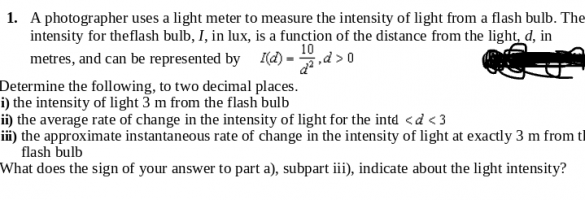Stouffville
New member
- Joined
- Sep 17, 2021
- Messages
- 33
A photographer uses a light meter to measure the intensity of light from a flash bulb. The intensity for theflash bulb, I, in lux, is a function of the distance from the light, d, in metres, and can be represented by

Determine the following, to two decimal places.
i) the intensity of light 3 m from the flash bulb
ii) the average rate of change in the intensity of light for the interval
iii) the approximate instantaneous rate of change in the intensity of light at exactly 3 m from the flash bulb
b) What does the sign of your answer to part a), subpart iii), indicate about the light intensity

Determine the following, to two decimal places.
i) the intensity of light 3 m from the flash bulb
ii) the average rate of change in the intensity of light for the interval

iii) the approximate instantaneous rate of change in the intensity of light at exactly 3 m from the flash bulb
b) What does the sign of your answer to part a), subpart iii), indicate about the light intensity

